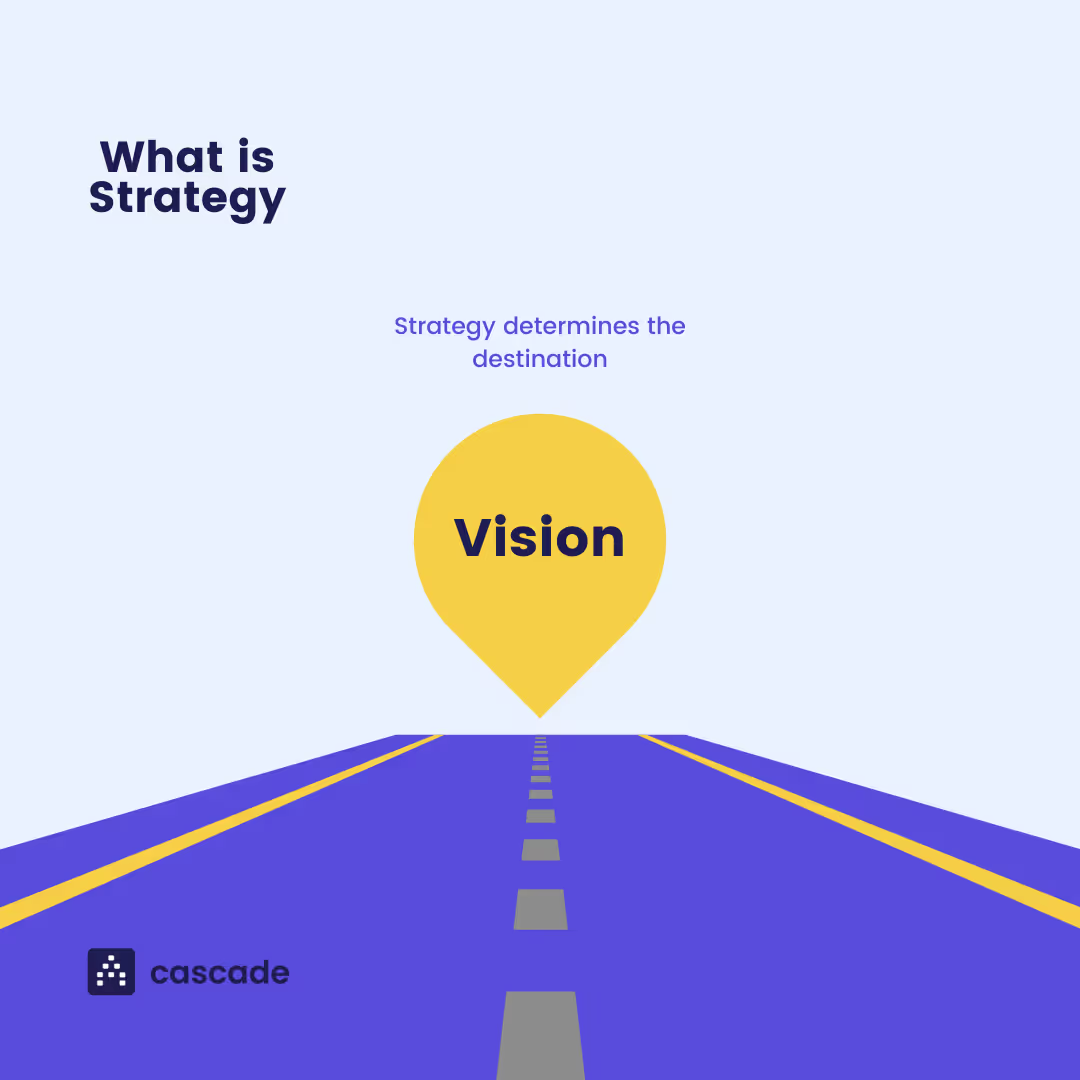Confusing strategy with tactics is a dangerous mistake. You've almost definitely heard these two terms used in various business contexts over the years.
Companies that mistake their tactics for their strategies are, at best, doomed to mediocre, temporary success. On the other hand, companies that develop strategic plans with little concern for their tactics fail to implement them.
So, when talking about strategy vs. tactics it’s important to know the difference and how they complement each other so you can effectively achieve those ambitious business goals.
In this article, we'll tackle the following questions:
- Strategy Vs. Tactics: Main Differences
- What Is Strategy?
- What Are Tactics?
- Strategy Vs. Tactics Examples
- How Strategy And Tactics Fit Together
- How To Measure Strategy Vs. Tactics
- Strategy Vs. Tactics: The Verdict
Strategy Vs. Tactics: Main Differences
In short, the difference between strategy and tactics can be summed up as “strategy determines where you want to go” and “tactics determine how you’ll get there”. Strategy is required to set the overarching direction and destination of the organization, and tactics are required to define the concrete actions you’ll take to reach your destination.
Clearly, strategy and tactics are complementary. In fact, no organization can be successful if it focuses only on business strategy or tactical planning.
As the famous saying says:
“Strategy without tactics is the slowest route to victory. Tactics without strategy is the noise before defeat.” - Sun Tzu, The Art Of War.
Let’s dig a little deeper into each one.
What Is Strategy?
Strategy is a set of decisions that get you to a specific destination. It’s the overarching approach you adopt to achieve the set of long-term goals you've chosen. Depending on the level of strategy being developed, it can be relatively high-level or more detailed.

Thus, a strategic plan is a document that outlines the high-level approach you choose. It explains how to achieve a long-term vision or mission for the company.
What makes a good strategy?
A good strategy is characterized by certain elements that contribute to its effectiveness in guiding decision-making and achieving long-term success.
Here are the fundamental elements that a good strategy must consider:
Focused on key metrics
An effective strategy is based on analyzing key metrics and relevant data to gain insights into the organization's performance and market dynamics. By focusing on these essential indicators, a good strategy can identify areas of improvement and align actions to achieve optimal outcomes.
Clear business goals
A good strategy sets clear and measurable business goals. These goals serve as the foundation for your business plan and provide a sense of direction for the entire organization. Clear business goals enable teams to align their efforts and resources toward a common long-term vision.
Rooted in reality and data
A successful strategy is rooted in a thorough understanding of the organization's capabilities, strengths, and weaknesses. It takes into account the current market conditions, competitive landscape, and potential challenges that may arise, supported by relevant data. By acknowledging reality and relying on data-driven insights, a good strategy becomes more pragmatic and achievable.
💡 Pro Tip: When crafting your strategy, consider first identifying the crucial metrics you want to achieve. Then, employ a "reverse engineering" approach to formulate your strategic plan. This involves defining the focus areas, objectives, initiatives, and Key Performance Indicators (KPIs) that will effectively help you achieve those key metrics.
What Are Tactics?
The meaning of tactics is the specific actions you take to achieve your short-term or long-term goals. They will most likely be informed by your strategic goals and approach, but they are far more specific.

Tactics are not outcomes, nor are they measures of success. Note that there is no mention of the specific actions that go into achieving your business goals in our definition of strategy. That's where tactics come into play.
What makes a good tactic?
Good tactics are vital for the success of your strategy since they’re the specific actions that will help you achieve your desired outcomes. They ensure the implementation and execution of those actions to support broader goals and objectives.
Good tactics must be:
Aligned with strategic goals
Effective tactics are closely aligned with the organization's strategic goals. They support the broader strategic direction and contribute directly to achieving the strategic objectives. When tactics are well-aligned with the overall strategy, you can be sure that every action taken is focused on driving the company toward achieving the key metrics you set in your strategic plan.
Short-term actions
Good tactics consist of short-term actions that lead to tangible progress. They break down the strategic plan into manageable steps, providing a focused and efficient approach to achieving objectives. Because of their short-term nature, you can easily track their progress and quickly pivot along the way, making them very adaptable and flexible.
Timebound and specific
A successful tactic has a clear timeline and is structured with deadlines, ensuring a solid commitment to achieving the expected results within the agreed timeframe. They also need to be specific. Defining specific tactics involves understanding their purpose and how you will measure success once they’re completed.
Strategy Vs. Tactics Examples
To make the distinction more concrete, let's look at an example of how an organization might move from a high-level strategy into a specific set of tactics.
We’ll use “Best Bicycles,” an imaginary bike manufacturing company:
Strategy: Differentiation
We will succeed by creating bikes with an innovative key component that our competitors can't immediately replicate, which will allow us to charge a price premium to customers.
Objective: Gain a competitive advantage by being recognized as the leading innovator in the space of on-bike health tracking technology.
Tactic 1: Launch a new Bluetooth-enabled module that attaches to the bike's spokes and sends performance data to a linked smartphone app.
Tactic 2: Send out free bikes to popular tech blogs and invite them to write gear reviews.
Tactic 3: Devise a digital marketing strategy that utilizes TikTok and Instagram with the ultimate goal to expand market share and drive engagement among Gen Zers.
Quite simple, right?
Now, let’s check out some real-life examples to make sure the concepts are clear:
Example 1: McDonald's
Strategy: Global Market Expansion
McDonald's, the fast-food giant, has a global strategy of expanding its presence in various countries to increase market share and revenue.
Tactic 1: Menu Localization
In different regions, McDonald's adapts its menu to cater to the local tastes and cultural preferences of their target audience. For example, in India, they offer a range of vegetarian options to accommodate the predominantly vegetarian diet of the population.
.avif)
Tactic 2: McDelivery and Mobile Ordering
To capitalize on the growing trend of food delivery and mobile ordering, McDonald's invested in online and mobile ordering platforms, making it more convenient for customers to order their favorite meals.
Tactic 3: Value Meal Promotions
McDonald's regularly runs value meal promotions to attract price-sensitive customers and increase foot traffic to their restaurants.
Example 2: Apple
Strategy: Product Differentiation and Innovation
Apple's strategy revolves around differentiating its products from competitors and focusing on continuous innovation to maintain a premium brand image.
Tactic 1: Introducing the iPhone
Apple's game-changing tactic was the launch of the iPhone in 2007, revolutionizing the smartphone industry with its touchscreen interface, sleek design, and seamless integration of hardware and software.
Tactic 2: Ecosystem Integration
Apple's ecosystem strategy encourages customers to buy multiple Apple products, as they work seamlessly together. For instance, iPhones sync effortlessly with Mac computers and other Apple devices, enhancing the user experience and promoting brand loyalty.
Tactic 3: Retail Store Experience
Apple invested in creating a unique and immersive retail store experience, providing customers with hands-on product demonstrations, customer support, and workshops. This approach enhances brand loyalty and creates a positive association with the Apple brand.
.avif)
Example 3: Coca-Cola Company
Strategy: Brand and Marketing Dominance
Coca-Cola's strategy is centered around building a strong brand image and dominating the beverage market through extensive marketing and distribution.
Tactic 1: Iconic Brand Identity
Coca-Cola has maintained a consistent brand identity with its signature red and white logo and memorable advertising campaigns that evoke positive emotions.
Tactic 2: Global Sponsorships and Partnerships
The company sponsors major events like the FIFA World Cup and partners with popular celebrities and influencers to reach diverse audiences and reinforce its brand image.
Tactic 3: Diverse Product Portfolio
Coca-Cola diversifies its product offerings to cater to different consumer preferences, including Coca-Cola Classic, Diet Coke, Coca-Cola Zero Sugar, and various flavored variants.
.avif)
As you can see, you will likely have multiple tactics aligned with each of your long-term strategy's objectives. And your overall strategic planning process will likely include tens, if not hundreds, of tactics in total.
How Strategy And Tactics Fit Together
Here’s how they fit together in the Cascade Strategy Model:
%2520(1).avif)
As you can see, the top half of the model is concerned with strategic thinking and strategic objectives, while tactics (Actions/Projects) come in towards the bottom alongside the measures of success - your KPIs.
How To Measure Strategy Vs. Tactics
Let's go back to our bike manufacturing company example.
Measuring strategy
Best Bicycles’ strategy is all about differentiation. it’s a solid strategy, and the company has set the objective of being recognized as an innovator in its market. Supporting this objective is a number of tactics.
But can we consider the strategic implementation successful so long as we execute those tactics? The answer is no.
Tactics are the best estimate of which short-term actions, when executed, will help the company achieve its strategic goals. But the tactics themselves are not a measure of the success of your strategy.
If we look at our strategy model once more, you'll see that we represent this by adding KPIs underneath the objectives and next to tactics. So, in our example, we would need to add some measurable business goals into the mix alongside our tactics, like:
- Be mentioned in at least 10 news articles that focus on transport innovation.
- Achieve a conversion rate of 5% on LinkedIn advertisements.
- Reach 10,000 monthly visitors on new blog posts.
The KPIs sit directly underneath the objective and are a key part of your action plan. Although they can be directly related or not to either of the tactics, they are used to measure their success and progress.
If you select your tactics carefully, write relevant KPIs, and hit your target metrics, then you will reach your objective.
Measuring tactics
Measuring the success of your tactics requires measuring whether you have reached your target KPIs over a specific timeframe or timeline. So, your tactics must progress your KPIs.
If your KPIs are not affected by your tactics, you either have useless tactics or ineffective KPIs.
For example, if one of your tactics is to improve your SEO through content marketing initiatives, you might measure your success by seeing how many keywords you can rank for on the front page of the SERPs. If you want to execute a social media marketing plan to achieve your goals, you might want to monitor your engagement rates over time.
Measuring your tactics' progress is far less important than measuring your strategy’s success.
It's also far easier since the measurement of tactics is typically quite similar to the post-implementation reviews that project managers undertake at the end of their projects. That is to say, that to measure its success, you will look at the tactic’s timeliness, its cost, and whether or not it was delivered in line with the initial scope.
💡Pro Tip: You can also use the OKR (Objectives and Key Results) methodology to track your goals in Cascade.
📚Recommended read: How to track OKRs, so you make consistent progress toward your goals
Strategy Vs. Tactics: The Verdict
Strategy is an umbrella term that consists of several parts, one of which is tactics. Strategy determines the destination, and tactics are the vehicle that gets you there. Measuring your progress toward your destination is far more important than measuring the efficiency of your vehicle.
Your vehicle might move you quickly but take you nowhere.
Align strategy and tactics in Cascade to hit your goals faster! 🎯
Cascade is the world’s #1 strategy execution platform, remediating the chaos of running a business to help you move forward. Move from chaos to clarity and ensure that your strategy and tactics are moving in the same direction!
With Cascade, you can:
- Add Actions (tactics) to your Objectives and track their progress by adding related KPIs.
- Set milestones for your tactics to break them down into smaller, more manageable items.
- Ask your team members to automatically input their progress updates and see how your tactics are moving forward.
- Create automated real-time dashboards and reports to understand how the strategy is progressing.
- Achieve full visibility and ensure all stakeholders can easily see how the tactics are aligned with the overall strategy.
Take Cascade for a spin! Sign up today for a free forever plan or book a guided 1:1 tour with one of our Cascade in-house strategy execution experts.
🤔Don’t know where to start? You can use our strategic planning template pre-filled with examples to kickstart your strategy planning. You can easily tailor it to fit your organization’s needs.



.avif)

.png)
.jpg)
.jpg)
%20(1)%20(1)%20(1)%20(1)%20(1).png)



